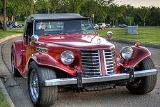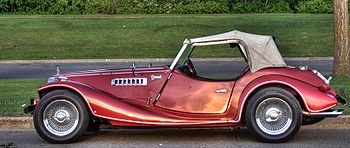
Blakely Bernardi
Encyclopedia

The Blakely Bernardi is an automobile produced in the 1980s by Blakely Auto Works
Blakely Auto Works
Blakely Auto Works was a manufacturer of automobiles and of kit cars, working from premises located in a series of US midwest communities including Princeton, Wisconsin in the 1970s and 1980s...
(also called Bernardi Auto Works in some references) of Princeton, Wisconsin
Princeton, Wisconsin
Princeton is a city in Green Lake County, Wisconsin, United States. The population was 1,504 at the 2000 census. The city is located within the Town of Princeton, though it is politically independent.-Transportion:...
, USA. Blakely produced a number of automobile models, including the Bearcat and Bantam
Blakely Bantam
The Blakely Bantam was a kit car produced by Blakely Auto Works , a manufacturer of kit cars located in a series of US midwest communities in the 1970s and 1980s. Blakely Auto was founded by Dick Blakely to market affordable sports cars in the spirit of the legendary Lotus Seven: compact,...
. The Bernardi was available as a completed car or as a kit of parts to be assembled by the buyer.
Design and construction
The Bernardi is a neo-classic design reminiscent of the 1950s British MG TD. The chassis is front-engine, rear-wheel drive with the engine located behind the front axle. It has a two-seat cab under a removable hardtop or convertible fabric top, flat windshield, three windshield wipers (like the MGBMG MGB
The MGB is a sports car launched by MG Cars in May 1962 to replace the MGA. Introduced as a four-cylinder roadster, a coupé with 2+2 seating was added in 1965...
Mark II), working doors, and detachable side curtains of fiberglass and plexiglass. In keeping with the traditional look of post-WWII British sports cars, the Bernardi's front fenders stand away from the body,and the headlights perch on stalks between the fenders and the hood. There is a functional, though fairly small, trunk in the back and a trunk-mounted external luggage rack. A small bench behind the seats was available as a factory option, with enough room to store small packages or accommodate a stereo system. Cars without the bench were equipped with a two-point chromed roll bar behind the cab, which fitted beneath the convertible roof. While the body style and proportions generally mimic the MG-TD, the Bernardi is noticeably larger in body width and has sufficient room under the hood to accommodate an American small-block V8 engine.
An overview of the build process for a Bernardi Blakely appeared in Kit Car World and gave significant detail about the Bernardi's general structure and some of its construction options. The basic construction is a Body-on-frame
Body-on-frame
Body-on-frame is an automobile construction method. Mounting a separate body to a rigid frame that supports the drivetrain was the original method of building automobiles, and its use continues to this day. The original frames were made of wood , but steel ladder frames became common in the 1930s...
design with a fiberglass body mounted on a pre-fabricated metal chassis. The factory-provided chassis is a custom ladder frame built of 2 inches (50.8 mm) by 3 inches (76.2 mm) rectangular steel tubing with a 5/16th inch wall thickness. The factory attached fuel and brake plumbing, as well the tail-light wiring bundle, to the frame before shipping.
The mechanical components, including engine, suspension, and transmission, could be drawn from the Ford Pinto, Mercury Bobcat, or Ford Mustang II. Based on these donor choices, the suspension is relatively unsophisticated, with a solid rear axle mounted on quarter-elliptical leaf springs. The donor leaf springs are cut approximately in half, with just one of the halves on each side of the differential making up the rear springing. The rear axle was actually mounted above the side rails of the frame, which kept the frame design simple but limited the axle's vertical range of movement. The front suspension is a somewhat sportier double-wishbone
Double wishbone suspension
In automobiles, a double wishbone suspension is an independent suspension design using two wishbone-shaped arms to locate the wheel. Each wishbone or arm has two mounting points to the chassis and one joint at the knuckle. The shock absorber and coil spring mount to the wishbones to control...
design, built from the donor car's lower A-arm and a custom upper A-arm, with coil-over shocks and the donor's disk brakes.
The car's body was built at the factory and featured an unusual form of fiberglass construction. Instead of a single layer of fiberglass, as is common in other kit cars, the Bernardi body tub (the portion between the passenger compartment and the frame or road) and other body components used a composite sandwich consisting of one layer of fiberglass, one of stiff plastic foam, and finally a second layer of fiberglass. The result is a heavier body than usual for kit cars, but one with reputedly greater stiffness and sound absorption than the single-layer approach. The hood hinged at the front, allowing easy access to the engine compartment. The colors for the visible parts of the body were molded into the fiberglass body parts as Gelcoat
Gelcoat
Gelcoat is a material used to provide a high-quality finish on the visible surface of a fibre-reinforced composite material. The most common gelcoats are based on epoxy or unsaturated polyester resin chemistry. Gelcoats are modified resins which are applied to moulds in the liquid state...
and the cars often appear with two-tone color schemes.
The factory attached the body's doors, windshield, hood, and trunk lid before shipping the kit to the buyer. Major mounting points between the body and the chassis were also pre-drilled at the factory with the body placed on the chassis, so that these items would line up properly when the buyer began assembling the vehicle. The Bernardi's complete hood tilted forward for easy access to the engine area, and was trimmed at the front with chrome-work from the Oldsmobile Cutlass.
The vehicle's interior upholstery was provided, in the form of pre-cut carpet, door trim, seat covers, a tonneau cover, and dash upholstery. When completed, the Bernardi interior was similar to a commercial automobile's, with upholstery or trim for all interior fiberglass panels. The dash was finished with vinyl fabric, and contained the speedometer, tachometer, and several engine gauges in the center console. The doors were also fabric-trimmed, with elastic-topped map pouches on both sides. Vents were installed in the dash to direct heated air to the windshield and to passenger seating positions. Despite these advanced features, contemporary reports suggest that the buyer's assembly time for the Bernardi was expected to be a relatively low 100 to 120 hours.
The car had options for using several types of engine. The smallest recommended powerplants included the 1.6 liter, 2 liter, or 2.3 liter 4-cylinder Pinto / Bobcat engines used by the smaller Blakely Bantam
Blakely Bantam
The Blakely Bantam was a kit car produced by Blakely Auto Works , a manufacturer of kit cars located in a series of US midwest communities in the 1970s and 1980s. Blakely Auto was founded by Dick Blakely to market affordable sports cars in the spirit of the legendary Lotus Seven: compact,...
. The Bernardi chassis was also amenable to larger engines like a 2.8 liter Ford or Chevrolet / Pontiac V6, and even the small-block Ford V8. All engine types mounted behind the front axle, making the chassis a front-mid-engine design with the attendant benefits in front-rear weight balance and low polar moment of inertia
Polar moment of inertia
Polar moment of inertia is a quantity used to predict an object's ability to resist torsion, in objects with an invariant circular cross section and no significant warping or out-of-plane deformation. It is used to calculate the angular displacement of an object subjected to a torque...
. Although the Bernardi was marketed as comfortable touring car, the car's combination of chassis layout, low weight, and V8 engine option resemble aggressive sports designs like the AC Cobra
AC Cobra
The AC Cobra, also known colloquially as the Shelby Cobra in North America, is an Anglo-American sports car that was produced during the 1960s.-History and development:...
.
Current status

A kit car's value lies not just in the cost of the car or its components, so a comparison with the Corvette's cost may not be fair. The Bernardi competed more directly against other neo-classic sports-car kits. Although the Bernardi offered superior body quality and the authentic front-engine design of the sports cars it resembled, its body and chassis were more complicated and costly than those of kits based on the Volkswagen Beetle, like the Fiberfab
Fiberfab
Fiberfab was a kit car manufacturer founded by Warren "Bud" Goodwin in 1964. They got their start building street rod parts and body panels for Mustangs before moving on to kit cars....
Migi MG-TD replica. These VW-based kits are much more common across the United States. Blakely Bernardis, although regularly appearing for sale at specialty dealers, do not have the contemporary high visibility of many other kit models.
External links
- Blakely Car blog
- Do-it-yourselfer's dream: The real fun of building a kit car is driving it when it's finished! Article from Popular Mechanics, October 1981

